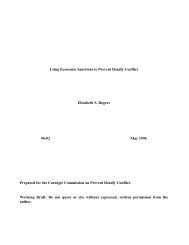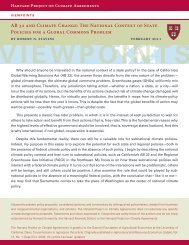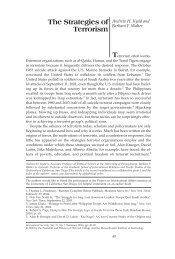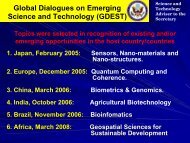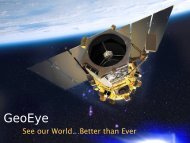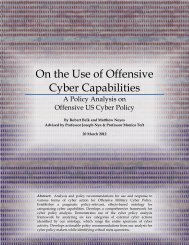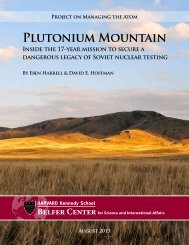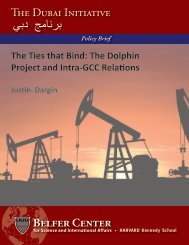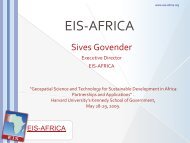A Political Plan for a Weapons of Mass Destruction-Free Zone ...
A Political Plan for a Weapons of Mass Destruction-Free Zone ...
A Political Plan for a Weapons of Mass Destruction-Free Zone ...
You also want an ePaper? Increase the reach of your titles
YUMPU automatically turns print PDFs into web optimized ePapers that Google loves.
A <strong>Political</strong> <strong>Plan</strong> <strong>for</strong> a <strong>Weapons</strong> <strong>of</strong><strong>Mass</strong> <strong>Destruction</strong>-<strong>Free</strong> <strong>Zone</strong>(WMDFZ) in the Middle EastHRH Prince Turki Al FaisalJuly 2013
A <strong>Political</strong> <strong>Plan</strong> <strong>for</strong> a <strong>Weapons</strong> <strong>of</strong><strong>Mass</strong> <strong>Destruction</strong>-<strong>Free</strong> <strong>Zone</strong>(WMDFZ) in the Middle EastHRH Prince Turki Al FaisalJuly 2013
Foreword by Graham AllisonWhat could lead four <strong>of</strong> America’s wisest statesmen and veteran Cold Warriors to advocate thatthe United States embrace the vision <strong>of</strong> a world without nuclear weapons? The considered, collectivejudgment <strong>of</strong> Henry Kissinger, Sam Nunn, William Perry and George Shultz that the paththe world is on today has brought us to a “nuclear tipping point.” These four statesmen havesounded an alarm about the likelihood that, on the current trajectory, the global nuclear order willunravel in ways that could lead to the spread <strong>of</strong> nuclear weapons, the destruction <strong>of</strong> great cities,and possibly even nuclear war.Recognizing that complacency could soon lead to cataclysmic results, the “four horsemen <strong>of</strong> theapocalypse”, as some have called them, have urged the international community to think again.Their example is a challenge to all <strong>of</strong> us: how can we use our imaginations to bend the trendlinescurrently pointing us towards unacceptable outcomes?HRH Prince Turki Al Faisal’s new plan boldly picks up the challenge. He has recognized that,in his words, “there is no more pressing international threat to peace and security than the proliferation<strong>of</strong> nuclear weapons and their possible use.” A veteran <strong>of</strong> international diplomacy, heunderstands that the path leading towards the summit <strong>of</strong> a world without nuclear weapons will bea long and hazardous climb. But he believes that real victories can be gained, and the security <strong>of</strong>the world enhanced, by aiming <strong>for</strong> achievable intermediate goals along the way.His proposal <strong>for</strong> a <strong>Weapons</strong> <strong>of</strong> <strong>Mass</strong> <strong>Destruction</strong> <strong>Free</strong> <strong>Zone</strong> in the Middle East seeks to injectmuch-needed energy into resolving a crucial issue that affects us all, none more than the peoples<strong>of</strong> the Middle East themselves. As we witness in Syria today, and perhaps with Iran in the nearfuture, nuclear, chemical and biological weapons pose real and deadly threats that demand ourutmost attention. Sadly, the international community has <strong>of</strong>ten clung to policies that, while embodyingthe best intentions, fail to tackle the obstacles to action.Proposals that stretch the boundaries <strong>of</strong> conventional thinking predictably invite objections.Many will be uncom<strong>for</strong>table with Prince Turki’s arguments, in whole or in part. But fresh thinkingsuch as his is in short supply. Even those who disagree entirely will be enriched by theexercise <strong>of</strong> engaging with his analysis. When conventional prescriptions may appear close toexhaustion, and the path <strong>of</strong> least resistance may lead to disaster, it is vital to reexamine longheldassumptions and explore all alternative pathways that could lead to a breakthrough from theBelfer Center <strong>for</strong> Science and International Affairs | Harvard Kennedy Schoolv
current stalemate in which the region finds itself. As Prince Turki suggests in his conclusion, ourdestination otherwise may be a new and more dangerous Middle East containing many nucleararmedstates, in which the risk <strong>of</strong> nuclear war would be greatly magnified.In arenas where current policies are likely to lead to catastrophic results, the challenge in proposingpolicy initiatives is not to <strong>of</strong>fer a good idea. It is sufficient that a proposal simply be betterthan the alternatives. Prince Turki Al Faisal’s perceptive, provocative plan seeks to meet that test.Readers will benefit from assessing it.Graham AllisonDirector, Belfer Center <strong>for</strong> Science and International AffairsviA <strong>Political</strong> <strong>Plan</strong> <strong>for</strong> a <strong>Weapons</strong> <strong>of</strong> <strong>Mass</strong> <strong>Destruction</strong>-<strong>Free</strong> <strong>Zone</strong> (WMDFZ) in the Middle East
Table <strong>of</strong> Contents1. Introduction........................................................................................................................................ 12. Too Much Ado about Nothing: Diplomacy <strong>of</strong> NWFZ and WMDFZ in the MENA Region............. 23. The GCC and Nuclear Power............................................................................................................ 54. Time to Act: Considering Alternatives............................................................................................... 65. Conclusion......................................................................................................................................... 8AppendixesAppendix A: Resolution 3263 <strong>of</strong> the U.N. General Assembly <strong>of</strong> 9 December, 1974..................... 11Appendix B: Resolution 3474 <strong>of</strong> the U.N. General Assembly <strong>of</strong> 1975.......................................... 14Appendix C: Resolution on the Middle East adopted at 1995NPT Review and Extension Conference................................................................... 16Appendix D: Appendix D: Reaffirmation <strong>of</strong> the 1995 Resolution in May 2010Review Conference Discussions Excerpt.................................................................. 18Belfer Center <strong>for</strong> Science and International Affairs | Harvard Kennedy Schoolvii
Introduction“Nuclear weapons are the only weapons ever invented that have the capacity to wholly destroylife on this planet, and the arsenals we now possess are able to do so many times over. Theproblem with nuclear weapons is at least equal to that <strong>of</strong> climate change in terms <strong>of</strong> gravity - andmuch more immediate in its potential impact. So long as any state has nuclear weapons, otherswill want them. So long as such weapons remain, it defies credibility that they will not one daybe used - by accident, miscalculation or design. And any such use would be catastrophic.”This statement from a report by the International Commission on Nuclear Non-Proliferation andDisarmament 1 delegitimizes nuclear weapons and is a case <strong>for</strong> their abolition, and it fits well withthe advisory opinion <strong>of</strong> the International Court <strong>of</strong> Justice in 1996 which stated: “the threat or use<strong>of</strong> nuclear weapons would generally be contrary to the rules <strong>of</strong> International Law applicable inarmed conflict, and in particular the principles and rules <strong>of</strong> humanitarian law.” 2 These clear andloud messages show that there is no more pressing international threat to peace and security thanthe proliferation <strong>of</strong> nuclear weapons and their possible use. If this serious threat is not matchedby the concerted determination <strong>of</strong> the international community to eliminate it, international peaceand security will remain a distant goal. Yet, while ridding the world <strong>of</strong> nuclear weapons andcreating an international consensus <strong>for</strong> the immediate need to progress toward this noble goal <strong>for</strong>the sake <strong>of</strong> humanity should be at the top <strong>of</strong> the agenda <strong>for</strong> all states, realization <strong>of</strong> such a goalremains highly elusive.1In 2008, I was privileged to be a member <strong>of</strong> the International Commission on Nuclear Non-Proliferation andDisarmament that was established by Australia and Japan to stimulate debate and build momentum <strong>for</strong> nuclear nonproliferationand disarmament in the lead-up to the NPT Review Conference <strong>for</strong> International Peace and Securitythat was held in 2010 in New York. My distinguished colleagues and I worked <strong>for</strong> over one year tackling all aspects<strong>of</strong> this issue and consulted experts from all over the world. We worked with governmental representatives, the globalnuclear power industry and Non-Governmental Organizations devoted to the cause <strong>of</strong> disarmament, as well as thoseresponsible <strong>for</strong> advancing and monitoring nuclear non-proliferation and disarmament. We concluded our missionby launching our report in Tokyo in December 2009, “Eliminating Nuclear Threats: A Practical Agenda <strong>for</strong> GlobalPolicymakers”, The report’s twenty-point action statement entitled “A New International Consensus on Action <strong>for</strong>Disarmament” was circulated to the Review Conference as a working paper from the Commission. The report isavailable at: http://www.cfr.org/proliferation/international-commission-nuclear-nonproliferation-disarmament-eliminating-nuclear-threats-practical-agenda-global-policymakers/p210212http://www.icj-cij.org/docket/files/95/7495.pdfBelfer Center <strong>for</strong> Science and International Affairs | Harvard Kennedy School 1
There is an Arab proverb that says:(مَا ال يُدْرَكُ كُلُّهُ ال يُتْرَكُ جُلُّهُ)“Not realizing all <strong>of</strong> an objective doesn’t mean some <strong>of</strong> it can’t be realized.” This is certainly thecase when tackling the issue <strong>of</strong> nuclear non-proliferation by the international community. Forinstance, establishing regional nuclear free zones was a rational necessary step toward riddingthe world <strong>of</strong> this dire threat. And this is well stated in paragraph 6 <strong>of</strong> the UN General AssemblyResolution Number 3263 which calls <strong>for</strong> the creation <strong>of</strong> such a zone in the Middle East. It reads:“the establishment <strong>of</strong> nuclear-weapon-free zones, on the initiative <strong>of</strong> the States situated withineach zone concerned, is one <strong>of</strong> the measures which can contribute most effectively to haltingthe proliferation <strong>of</strong> those instruments <strong>of</strong> mass destruction and to promoting progress towardsnuclear disarmament, with the goal <strong>of</strong> total destruction <strong>of</strong> all nuclear weapons and their means <strong>of</strong>delivery”. 3No region in the world is in greater need <strong>of</strong> becoming such a zone than the conflict-cursedMiddle East. This region is in the midst <strong>of</strong> a drastic trans<strong>for</strong>mation. One <strong>of</strong> its states (Israel) is ade facto nuclear weapon state and another one (Iran) is progressing toward becoming one. Bothcountries have lied about their intentions in this regard. Israel publicly stated that it would notintroduce nuclear weapons into the Middle East, yet it has over 200 warheads with the requireddelivery systems. Iran has publicly stated that it seeks the peaceful development <strong>of</strong> nuclearpower, yet it continues to raise enrichment levels in its centrifuges while increasing their numberand preventing IAEA inspectors from inspecting suspected sites.Given the importance <strong>of</strong> this issue in this region and the current political changes taking placethere, this paper aims to address the issue <strong>of</strong> establishing a <strong>Weapons</strong> <strong>of</strong> <strong>Mass</strong> <strong>Destruction</strong> <strong>Free</strong><strong>Zone</strong> (WMDFZ) in the Middle East in order to realize the objective <strong>of</strong> ridding the region <strong>of</strong>weapons <strong>of</strong> mass destruction.Too Much Ado about Nothing: Diplomacy <strong>of</strong> NWFZand WMDFZ in the MENA RegionThe proposal <strong>of</strong> Egypt and Iran to create a NWFZ in the Middle East and its approval on3Resolution 3263 <strong>of</strong> the U.N. General Assembly <strong>of</strong> 9 December, 1974. Available at: http://daccess-dds-ny.un.org/doc/RESOLUTION/GEN/NR0/738/64/IMG/NR073864.pdf?OpenElement2A <strong>Political</strong> <strong>Plan</strong> <strong>for</strong> a <strong>Weapons</strong> <strong>of</strong> <strong>Mass</strong> <strong>Destruction</strong>-<strong>Free</strong> <strong>Zone</strong> (WMDFZ) in the Middle East
December 9, 1974 by General Assembly Resolution 3263 initiated a protracted diplomaticprocess that, so far, has failed to realize this objective or even bring us closer to it. ThisResolution “commends the idea <strong>of</strong> the establishment <strong>of</strong> a nuclear-weapon-free zone in theregion <strong>of</strong> the Middle East; considers that, in order to advance the idea <strong>of</strong> a nuclear-weaponfreezone in the region <strong>of</strong> the Middle East, it is indispensable that all parties concerned in thearea proclaim solemnly and immediately their intention to refrain, on a reciprocal basis, fromproducing, testing, obtaining, acquiring or in any other way possessing nuclear weapons; callsupon the parties concerned in the area to accede to the Treaty on the Non-Proliferation <strong>of</strong>Nuclear <strong>Weapons</strong> (NPT); expresses the hope that all States, in particular the Nuclear-WeaponStates(NWS), will lend their full co-operation <strong>for</strong> the effective realization <strong>of</strong> the aims <strong>of</strong> thepresent resolution”. 4In the thirtieth session <strong>of</strong> the UN General Assembly in 1975, Resolution 3474 was adopted, addingnew provisions and recommending that “states <strong>of</strong> the region, pending the establishment <strong>of</strong>the nuclear-weapon-free zone under an effective system <strong>of</strong> safeguards, should:(a) “Proclaim solemnly and immediately their intention to refrain, on a reciprocal basis, fromproducing, acquiring or in any other way possessing nuclear weapons and nuclear explosivedevices, and from permitting the stationing <strong>of</strong> nuclear weapons, in their territory orthe territory under their control, by any third party;(b) Refrain, on a reciprocal basis, from any other action that would facilitate the acquisition,testing or use <strong>of</strong> such weapons, or would be in any other way detrimental to the objective<strong>of</strong> the establishment <strong>of</strong> a nuclear-weapon-free zone in the region under an effectivesystem <strong>of</strong> safeguards.”The resolution also urges “the Nuclear-Weapon States to refrain from any action contrary to thepurpose <strong>of</strong> the present resolution and the objective <strong>of</strong> establishing, in the region <strong>of</strong> the MiddleEast, a nuclear weapon-free zone under an effective system <strong>of</strong> safeguards and to extend theircooperation to the states <strong>of</strong> the region in their ef<strong>for</strong>ts to promote this objective.” 54Resolution 3263 <strong>of</strong> the U.N. General Assembly <strong>of</strong> 9 December, 1974. Available at: http://daccess-dds-ny.un.org/doc/RESOLUTION/GEN/NR0/738/64/IMG/NR073864.pdf?OpenElement5Resolution 3474 <strong>of</strong> the U.N. General Assembly <strong>of</strong> 1975. Available at: http://daccess-dds-ny.un.org/doc/RESOLU-TION/GEN/NR0/001/87/IMG/NR000187.pdf?OpenElementBelfer Center <strong>for</strong> Science and International Affairs | Harvard Kennedy School 3
a resolution to call <strong>for</strong> establishing the zone in 1974. In fact, quite <strong>of</strong>ten, from the early 1970’still now, Iran joined with other nations to work through the United Nations to attempt to gainsupport <strong>for</strong> what was then called a Nuclear <strong>Weapons</strong> <strong>Free</strong> <strong>Zone</strong>.And yet, despite all these ef<strong>for</strong>ts, our region can hardly be called free <strong>of</strong> weapons <strong>of</strong> mass destruction.Indeed, the Middle East is the most militarized region in the world today, largely dueto the many conflicts that have raged and still rage in the area. While soldiers, tanks, and planeshave been growing in number in the area <strong>for</strong> some time, the Iraq-Iran War, from 1980–1988, andthe second Gulf War <strong>of</strong> 1991, increased the danger <strong>of</strong> proliferation <strong>of</strong> WMD’s in the region, aswell as ballistic missiles capable <strong>of</strong> carrying them.States seek WMD’s <strong>for</strong> various reasons, including deterrence, arms races with neighbors, theability to attack or project the ability to attack, or to spare the high cost <strong>of</strong> conventional weapons.The first nation in the region to acquire nuclear capability was Israel. One can follow this tragicarc right up to the announcement <strong>of</strong> the IAEA that it had found incontrovertible evidence <strong>of</strong> Iranworking to develop nuclear weapons. And now we are witnessing the use <strong>of</strong> chemical weaponsby Bashar Al Assad against his people, which is immediate pro<strong>of</strong> that we need the zone yesterday,not tomorrow.Saudi Arabia firmly believes that it is in every nation’s interest, including Israel’s and Iran’s, notto possess nuclear weapons. This is why, through various initiatives, we are sending messagesto Iran that it is their right, as it is any nation’s right, and as we ourselves are doing, to developa civilian nuclear program, but that trying to parlay that program into nuclear weapons is a deadend, and that wiser choices will result in wider riches. A WMDFZ is the best means to get Iranand Israel to give up nuclear weapons.Barring the current Iranian support <strong>for</strong> a WMDFZ, the IAEA reports on Iranian nuclear capabilitiesare disturbing. But dealing with this issue by unilateral or unsanctioned military strikeswould be entirely counter-productive and would be seen by the people <strong>of</strong> the region as pro<strong>of</strong> <strong>of</strong>the double standards <strong>of</strong> American and European policies toward the region.Despite the Israeli denial policy and its excuses <strong>of</strong> not having the regional peace that responds toits own interests and ambitions in the Arab-Israeli conflict, it is well known that Israel’s unwillingnessto cease its unlawful colonization and continuous refusal to grant the Palestinians theirown homeland is the core reason that this conflict continues. There is no lack <strong>of</strong> proposals <strong>for</strong>Belfer Center <strong>for</strong> Science and International Affairs | Harvard Kennedy School 7
cause <strong>of</strong> the 2010 proposal. Such steps include:1. A major push on chemical weapons, including the removal <strong>of</strong> chemical weapons from Syriain the near term, followed by Syrian, Israeli and Egyptian accession to the CWC. A similaref<strong>for</strong>t could be made to achieve universal regional accession to the BWC.2. The declaration <strong>of</strong> the establishment <strong>of</strong> sub-regional zones, with mutual verification arrangementsthat could add nonproliferation assurances <strong>for</strong> the whole area and providemodel legal frameworks and technical cooperation <strong>for</strong> an expanded region-wide zone.In the end, these challenges can be met by the same principle that recognized the reality <strong>of</strong>Israel’s nuclear weapons and guided the IAEA to investigate and then announce the truth behindIran’s nuclear program. Of all the ef<strong>for</strong>ts in any upcoming conference that could be taken up <strong>for</strong>the sake <strong>of</strong> peace and security in the region and the world, I suggest that the global communityrepresented by the UN Security Council take on the issue under Chapter Seven <strong>of</strong> the UN Charterand:1. Create a WMDFZ in the Middle East.2. State that all activities by member states deemed contributory to nuclear weapons developmentcease immediately and be put under IAEA inspection.3. Guarantee a nuclear security umbrella by the permanent members <strong>of</strong> the Security Council<strong>for</strong> states that join.4. Reward these states with economic and technical support to develop peaceful uses <strong>of</strong>nuclear power.5. Guarantee, by the five permanent members <strong>of</strong> the Council, that countries that don’t join andare seen to be developing weapons <strong>of</strong> mass destruction will face not only economic andpolitical sanction but also military sanction.6. Establish a regional security <strong>for</strong>um, open to all states <strong>of</strong> the region with, authority to convenediscussions <strong>of</strong> a broad range <strong>of</strong> regional security issues, including the implementation<strong>of</strong> the 242 & 338 UN Security Council resolutions and the Arab Peace Initiative as well asWMD arms control and disarmament.This declaration will not immediately establish the WMDFZ. A period <strong>of</strong> five to ten years shouldBelfer Center <strong>for</strong> Science and International Affairs | Harvard Kennedy School 9
Appendix A: Resolution 3263 <strong>of</strong> the U.N. GeneralAssembly <strong>of</strong> 9 December, 19743263 (XXIX). Establishment <strong>of</strong> a nuclear-weapon-free zone in the region <strong>of</strong> the MiddleEast.The General Assembly,Having considered the question <strong>of</strong> the establishment <strong>of</strong> a nuclear-weapon-free zone in theregion <strong>of</strong> the Middle East,Desiring to contribute to the maintenance <strong>of</strong> international peace and security by bolsteringand expanding the existing regional and global structures <strong>for</strong> the prohibition and/or prevention<strong>of</strong> the further spread <strong>of</strong> nuclear weapons,Realizing that the establishment <strong>of</strong> nuclear-weapon-free zones with an adequate system<strong>of</strong> safeguards could accelerate the process towards nuclear disarmament and the ultimate goal <strong>of</strong>general and complete disarmament under effective international control,Recalling the resolution adopted by the Council <strong>of</strong> the League <strong>of</strong> Arab States at its sixtysecondsession, held in Cairo from 1 to 4 September 1974, on this subject,Recalling the message sent by His Imperial Majesty the Shahanshah <strong>of</strong> Iran on 16 September1974 on the establishment <strong>of</strong> the nuclear-weapon-free zone in the region <strong>of</strong> the MiddleEast, 41 Considering that the establishment <strong>of</strong> the nuclear-weapon-free zones, on the initiative <strong>of</strong>the States situated within each zone concerned, is one <strong>of</strong> the measures which can contribute mosteffectively to halting the proliferation <strong>of</strong> those instruments <strong>of</strong> mass destruction and to promotingprogress towards nuclear disarmament, with the goal <strong>of</strong> total destruction <strong>of</strong> all nuclear weaponsand their means <strong>of</strong> delivery,Mindful <strong>of</strong> the political conditions particular to the region <strong>of</strong> the Middle East and <strong>of</strong> thepotential danger emanating therefrom, which would be further aggravated by the introduction <strong>of</strong>Belfer Center <strong>for</strong> Science and International Affairs | Harvard Kennedy School 11
nuclear weapons in the area,Conscious, there<strong>for</strong>e, <strong>of</strong> the need to keep the countries <strong>of</strong> the region from becoming involvedin a ruinous nuclear arms race,Recalling the Declaration on the Denuclearization <strong>of</strong> Africa issued by the Assembly <strong>of</strong>Heads <strong>of</strong> State and Government <strong>of</strong> the Organization <strong>of</strong> African Unity in July 1964, 42Noting that the establishment <strong>of</strong> nuclear-weapon-free zone in the region <strong>of</strong> the MiddleEast would contribute effectively to the realization <strong>of</strong> aims enunciated in the Declaration on theDenuclearization <strong>of</strong> Africa,Recalling the notable achievement <strong>of</strong> the countries <strong>of</strong> Latin America in establishing anuclear-free zone,Also recalling resolution B <strong>of</strong> the Conference <strong>of</strong> Non-Nuclear-Weapon States, held atGeneva from 29 August to 28 September 1968, in which the Conference recommended that thenon-nuclear-weapon States not comprised in the Latin American nuclear-free zone should studythe possibility and desirability <strong>of</strong> establishing military denuclearization <strong>of</strong> their respective zones,43Recalling the aims pursued by the Treaty on the Non-Proliferation <strong>of</strong> Nuclear <strong>Weapons</strong> 44 ,in particular the goal <strong>of</strong> preventing the further spread <strong>of</strong> nuclear weapons,Recalling its resolution 2373 (XXII) <strong>of</strong> 12 June 1968, in which it expressed the hope <strong>for</strong>the widest possible adherence to the Treaty on the Non-Proliferation <strong>of</strong> Nuclear <strong>Weapons</strong> by bothnuclear-weapon and non-nuclear-weapon States,1. Commends the idea <strong>of</strong> the establishment <strong>of</strong> nuclear-weapon-free zone in the region <strong>of</strong> the MiddleEast;2. Considers that, in order to advance the idea <strong>of</strong> a nuclear-weapon-free zone in the region <strong>of</strong> theMiddle East, it is indispensable that all parties concerned in the area proclaim solemnly and 1 immediately41Official Records <strong>of</strong> the General Assembly. Twenty-ninth Session, Annexes, agenda item 101, document A/9693/Add.3.42Ibid., Twentieth Session, Annexes, agenda item 105, document A/5975.43Ibid., Twenty-third Session, agenda item 96, document A/7277 and Corr.1 and 2. para. 17.12A <strong>Political</strong> <strong>Plan</strong> <strong>for</strong> a <strong>Weapons</strong> <strong>of</strong> <strong>Mass</strong> <strong>Destruction</strong>-<strong>Free</strong> <strong>Zone</strong> (WMDFZ) in the Middle East
3263 (XXIX) should exert ef<strong>for</strong>ts towards the realization <strong>of</strong> the objective <strong>of</strong> establishing a nuclearweapon-freezone in the region <strong>of</strong> the Middle East;2. Urges all parties directly concerned to adhere to the Treaty on the Non-Proliferation <strong>of</strong> Nuclear<strong>Weapons</strong> as a means <strong>of</strong> promoting this objectives;3. Recommends that the Member States referred to in paragraph 1 above, pending the establishmentnuclear-weapon-free zone under an effective system <strong>of</strong> safeguards, should:a. Proclaim solemnly and immediately their intention to refrain, on a reciprocal basis,from producing, acquiring or in any other way possessing nuclear weapons and nuclearexplosive devices, and from permitting the stationing <strong>of</strong> nuclear weapons, in theirterritory or the territory under their control, by any third party;b. Refrain, on a reciprocal basis, from any other action that would facilitate the acquisition,testing or use <strong>of</strong> such weapons, or would be in any other way detrimental to the objective<strong>of</strong> the establishment <strong>of</strong> a nuclear-weapon-free zone in the region under an effectivesystem <strong>of</strong> safeguards;4. Recommends to the nuclear-weapon States to refrain from any action contrary to the purpose<strong>of</strong> the present resolution and the objective <strong>of</strong> establishing, in the region <strong>of</strong> the Middle East, a nuclearweapon-freezone under an effective system <strong>of</strong> safeguards and to extend their co-operation to the States ifthe region in their ef<strong>for</strong>ts to promote this objective;5. Decides to include in the provisional agenda <strong>of</strong> its thirty-first session the item entitled“Establishment <strong>of</strong> a nuclear-weapon-free zone in the region <strong>of</strong> the Middle East”. 2 2437 th plenary meeting11 December 197539Official Records <strong>of</strong> the Security Council, Thirtieth Year, Supplement <strong>for</strong> July, August and September 1975, documentsS/11778 and Add.1-3 and ibid., Supplement <strong>for</strong> October, November and December 1975, document S/11778/Add.4; A/10221 and Add.1 and 2.40Official Records <strong>of</strong> the General Assembly, Thirtieth Session, Supplement No. 27A (A.10027.Add.1), Annex I.41Resolution 2373 (XXII), annex.Belfer Center <strong>for</strong> Science and International Affairs | Harvard Kennedy School 15
Appendix C: Resolution on the Middle East adopted at1995 NPT Review and Extension ConferenceResolution on the Middle EastThe Conference <strong>of</strong> the Parties to the Treaty on the Non-Proliferation <strong>of</strong> Nuclear <strong>Weapons</strong>,Reaffirming the purpose and provisions <strong>of</strong> the Treaty on the Non-Proliferation <strong>of</strong> Nuclear <strong>Weapons</strong>,Recognizing that, pursuant to article VII <strong>of</strong> the Treaty, the establishment <strong>of</strong> nuclear-weapon-freezones contributes to strengthening the international non-proliferation regime,Recalling that the Security Council, in its statement 31 January 1992, affirmed that the proliferation<strong>of</strong> nuclear and all other weapons <strong>of</strong> mass destruction constituted a threat to internationalpeace and security,Recalling also General Assembly resolutions adopted by consensus supporting the establishment<strong>of</strong> a nuclear-weapon-free zone in the Middle East, the latest <strong>of</strong> which is resolution 49/71 <strong>of</strong> 15December 1994,Recalling further the relevant resolutions adopted by the General Conference <strong>of</strong> the InternationalAtomic Energy Agency concerning the application <strong>of</strong> Agency safeguards in the Middle East, thelatest <strong>of</strong> which is GC(XXXVIII)/RES/21 <strong>of</strong> 23 September 1994, and noting the danger <strong>of</strong> nuclearproliferation, especially in areas <strong>of</strong> tension,Bearing in mind Security Council resolution 687 (1991) and in particular paragraph 14 there<strong>of</strong>,Noting Security Council resolution 984 (1995) and paragraph 8 <strong>of</strong> the decision on principles andobjectives <strong>for</strong> nuclear non-proliferation and disarmament adopted by the Conference in 11 May1995,Bearing in mind the other decisions adopted by the Conference on 11 May 1995,1. Endorses the aims and objectives <strong>of</strong> the Middle East peace process and recognizes that ef<strong>for</strong>ts in16A <strong>Political</strong> <strong>Plan</strong> <strong>for</strong> a <strong>Weapons</strong> <strong>of</strong> <strong>Mass</strong> <strong>Destruction</strong>-<strong>Free</strong> <strong>Zone</strong> (WMDFZ) in the Middle East
this regard, as well as other ef<strong>for</strong>ts, contribute to, inter alia, a Middle East zone free <strong>of</strong> nuclear weapons aswell as other weapons <strong>of</strong> mass destruction;2. Notes with satisfaction that, in its report (NPT/CONF.1995/MC.III/1), Main Committee III <strong>of</strong> theConference recommended that the Conference “call on those remaining States not parties to the Treatyto accede to it, thereby accepting an international legally commitment not to acquire nuclear weaponsor nuclear explosive devices and to accept International Atomic Energy Agency safeguards on all theirnuclear activities”;3. Notes with concern the continued existence in the Middle East <strong>of</strong> unsafeguarded nuclearfacilities, and reaffirms in this connection the recommendation contained in section VI, paragraph 3, <strong>of</strong>the report <strong>of</strong> the Main Committee III urging those non-parties to the Treaty on the Non-Proliferation <strong>of</strong>Nuclear <strong>Weapons</strong> that operate unsafeguarded nuclear facilities to accept full-scope International AtomicEnergy Agency safeguards;4. Reaffirms the importance <strong>of</strong> the early realization <strong>of</strong> universal adherence to the Treaty, and callsupon all States <strong>of</strong> the Middle East that have not yet done so, without exception, to accede to the Treaty assoon as possible and to place their nuclear facilities under full-scope International Atomic Energy Agencysafeguards;5. Calls upon all States in the Middle East to take practical steps in appropriate <strong>for</strong>ums aimed atmaking progress towards, inter alia, the establishment <strong>of</strong> an effectively verifiable Middle East zone free <strong>of</strong>weapons <strong>of</strong> mass destruction, nuclear, chemical and biological, and their delivery systems, and to refrainfrom taking any measures that preclude the achievement <strong>of</strong> this objective;6. Calls upon all States party to the Treaty on the Non-Proliferation <strong>of</strong> Nuclear <strong>Weapons</strong>, and inparticular the nuclear-weapon States, to extend their cooperation and to exert their utmost ef<strong>for</strong>ts with aview to ensuring the early establishment by regional parties <strong>of</strong> a Middle East zone free <strong>of</strong> nuclear and allother weapons <strong>of</strong> mass destruction and their delivery systems.Belfer Center <strong>for</strong> Science and International Affairs | Harvard Kennedy School 17
Appendix D: Reaffirmation <strong>of</strong> the 1995 Resolution inMay 2010 Review Conference Discussions ExcerptIV. The Middle East, particularly implementation <strong>of</strong> the 1995 Resolution on the MiddleEast1. The Conference reaffirms the importance <strong>of</strong> the Resolution on the Middle East adopted by the1995 Review and Extension Conference and recalls the affirmation <strong>of</strong> its goals and objectives by the2000 Review Conference <strong>of</strong> the Parties to the Treaty on the Non-Proliferation <strong>of</strong> Nuclear <strong>Weapons</strong>. TheConference stresses that the resolution remains valid until the goals and objectives are achieved. Theresolution, which was co-sponsored by the depository States <strong>of</strong> the Treaty on the Non-Proliferation <strong>of</strong>Nuclear <strong>Weapons</strong> (the Russian Federation, the United Kingdom <strong>of</strong> Great Britain and Northern Irelandand the United States <strong>of</strong> America), is an essential element <strong>of</strong> the outcome <strong>of</strong> the 1995 Conference and<strong>of</strong> the basis on which the Treaty was indefinitely extended without a vote in 1995. States parties renewtheir resolve to undertake, individually and collectively, all necessary measures aimed at its promptimplementation.2. The Conference reaffirms its endorsement <strong>of</strong> the aims and objectives <strong>of</strong> the Middle East peaceprocess, and recognizes that ef<strong>for</strong>ts in this regard, as well as other ef<strong>for</strong>ts, contribute to, inter alia, aMiddle East zone free <strong>of</strong> nuclear weapons as well as other weapons <strong>of</strong> mass destruction.3. The Conference takes note <strong>of</strong> the reaffirmation at the 2010 Review Conference by the fivenuclear-weapon States <strong>of</strong> their commitment to a full implementation <strong>of</strong> the 1995 Resolution on theMiddle East.4. The Conference regrets that little progress has been achieved towards the implementation <strong>of</strong> the1995 Resolution on the Middle East.5. The Conference recalls the reaffirmation by the 2000 Review Conference <strong>of</strong> the importance <strong>of</strong>Israel’s accession to the Treaty and the placement <strong>of</strong> all its nuclear facilities under comprehensive IAEAsafeguards. The Conference reaffirms the urgency and the importance <strong>of</strong> achieving universality <strong>of</strong> theTreaty. The Conference calls on all States <strong>of</strong> the Middle East that have not yet done so to accede to the18A <strong>Political</strong> <strong>Plan</strong> <strong>for</strong> a <strong>Weapons</strong> <strong>of</strong> <strong>Mass</strong> <strong>Destruction</strong>-<strong>Free</strong> <strong>Zone</strong> (WMDFZ) in the Middle East
Treaty as non-nuclear-weapon States so as to achieve its universality at an early date.6. The Conference stresses the necessity <strong>of</strong> strict adherence by all States parties to their obligationsand commitments under the Treaty. The Conference urges all States in the region to take relevant stepsand confidence-building measures to contribute to the realization <strong>of</strong> the objectives <strong>of</strong> the 1995 Resolutionon the Middle East and calls upon all States to refrain from undertaking any measures that preclude theachievement <strong>of</strong> this objective.7. The Conference emphasizes the importance <strong>of</strong> a process leading to full implementation <strong>of</strong> the1995 Resolution on the Middle East. To that end, the Conference endorses the following practical steps:a. The Secretary-General <strong>of</strong> the United Nations and the co-sponsors <strong>of</strong> the 1995 Resolution,in consultation with the States <strong>of</strong> the region, will convene a conference in 2012, to beattended by all the States <strong>of</strong> the Middle East, on the establishment <strong>of</strong> the Middle Eastzone free <strong>of</strong> nuclear weapons and all other weapons <strong>of</strong> mass destruction, on the basis <strong>of</strong>arrangements freely arrived at by the States <strong>of</strong> the region, and with the full support andengagement <strong>of</strong> the nuclear-weapon States. The 2012 Conference shall take as its terms <strong>of</strong>reference the 1995 Resolution;b. Appointment by the Secretary-General <strong>of</strong> the United Nations and the co-sponsors <strong>of</strong>the 1995 Resolution, in consultation with the States <strong>of</strong> the region, <strong>of</strong> a facilitator, with amandate to support implementation <strong>of</strong> the 1995 Resolution by conducting consultationswith the States <strong>of</strong> the region in that regard and undertaking preparations <strong>for</strong> the convening<strong>of</strong> the 2012 Conference. The facilitator will also assist in implementation <strong>of</strong> follow-onsteps agreed by the participating regional States at the 2012 Conference. The facilitatorwill report to the 2015 Review Conference and its Preparatory Committee meetings;c. Designation by the Secretary-General <strong>of</strong> the United Nations and the so-sponsors <strong>of</strong> the1995 Resolution, in consultation with the States <strong>of</strong> the region, <strong>of</strong> a host Government <strong>for</strong>the 2012 Conference;d. Additional steps aimed at supporting the implementation <strong>of</strong> the 1995 Resolution,including the IAEA, the Organisation <strong>for</strong> the Prohibition <strong>of</strong> Chemical <strong>Weapons</strong> and otherrelevant international organizations be requested to prepare background documentation<strong>for</strong> the 2012 Conference regarding modalities <strong>for</strong> a zone free <strong>of</strong> nuclear weapons andother weapons <strong>of</strong> mass destruction and their delivery systems, taking into account workBelfer Center <strong>for</strong> Science and International Affairs | Harvard Kennedy School 19
previously undertaking and experience gained;e. Consideration <strong>of</strong> all <strong>of</strong>fers aimed at supporting the implementation <strong>of</strong> the 1995Resolution, including the <strong>of</strong>fer <strong>of</strong> the European Union to host a follow-on seminar to thatorganized in June 2008.8. The Conference emphasizes the requirement <strong>of</strong> maintaining parallel progress, in substanceand timing, in the process leading to achieving total and complete elimination <strong>of</strong> all weapons <strong>of</strong> massdestruction in the region, nuclear, chemical and biological.9. The Conference reaffirms that all States parties to the Treaty, particularly the nuclear-weaponStates and the States in the region, should continue to report on steps taken to implement the 1995Resolution, through the United Nations Secretariat, to the President <strong>of</strong> the 2015 Review Conference,as well as to the Chairperson <strong>of</strong> the Preparatory Committee meetings to be held in advance <strong>of</strong> thatConference.10. The Conference further recognizes the important role played by civil society in contributing to theimplementation <strong>of</strong> the 1995 Resolution and encourages all ef<strong>for</strong>ts in this regard.Other regional issue1. The Conference strongly urges the Democratic People’s Republic <strong>of</strong> Korea to fulfil thecommitments under the Six-Party Talks, including the complete and verifiable abandonment <strong>of</strong> all nuclearweapons and existing nuclear programmes in accordance with the September 2005 joint statement, andurges the Democratic People’s Republic <strong>of</strong> Korea to return, at an early date, to the Treaty and to itsadherence with its IAEA safeguards agreement. The Conference also calls on the Democratic People’sRepublic <strong>of</strong> Korea and all States parties to fully implement all relevant nuclear non-proliferation anddisarmament obligations. The Conference reaffirms its firm support <strong>for</strong> the Sox-Party Talks and remainsdetermined to achieve the satisfactory and comprehensive resolution to the issues involved throughdiplomatic means.20A <strong>Political</strong> <strong>Plan</strong> <strong>for</strong> a <strong>Weapons</strong> <strong>of</strong> <strong>Mass</strong> <strong>Destruction</strong>-<strong>Free</strong> <strong>Zone</strong> (WMDFZ) in the Middle East
Belfer Center <strong>for</strong> Science and International AffairsHarvard Kennedy School79 JFK StreetCambridge, MA 02138Fax: (617) 495-8963Email: belfer_center@harvard.eduWebsite: http://belfercenter.orgCopyright 2013 President and Fellows <strong>of</strong> Harvard College



